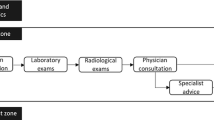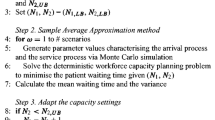Abstract
Unlike ordinary outpatient clinics, an emergency care center sees a variety of patients with diverse diseases and injuries of different levels of severity. Since patients who are in a critical condition face serious consequences, target waiting times must be determined based on patient acuity levels. To reflect the special situation in emergency care centers included in this study, patient flows are formulated using an open Jackson network with multiple patient classes. This paper is unique because of the integration of pooling and prioritizing patient classes with the open Jackson network. In particular, a hybrid priority model is presented in which a first-come-first-served discipline is applied in some processes and a priority discipline is applied in other processes in the open Jackson network, in order to minimize waiting times for patients with more urgent concerns. A case study based on actual data from an emergency care center demonstrates that the proposed model of pooling and prioritizing patient classes is effective in decreasing waiting times for higher-priority classes without substantially sacrificing those for lower-priority classes.








Similar content being viewed by others
References
Abujudeh, H., Vuong, B., & Baker, S. R. (2005). Quality and operations of portable X-ray examination procedures in the emergency room: queuing theory at work. Emergency Radiology, 11, 262–266.
Albin, S. L., Barrett, J., Ito, D., & Mueller, J. E. (1990). A queueing network analysis of a health center. Queueing Systems, 7, 51–61.
Au-Yeung, S. W. M., Harrison, P. G., & Knottenbelt, W. J. (2006). A queueing network model of patient flow in an accident and emergency department. In The 20th annual European and simulation modeling conference, France, October 2006 (pp. 60–67).
Blackwell, T. H., & Kaufman, J. S. (2002). Response time effectiveness: comparison of response time and survival in an urban emergency medical services system. Academic Emergency Medicine, 9, 288–295.
Boudreaux, E. D., & O’Hea, E. L. (2004). Patient satisfaction in the emergency department: a review of the literature and implications for practice. The Journal of Emergency Medicine, 26, 13–26.
Chaussalet, T. J., Xie, H., & Millard, P. (2006). A closed queueing network approach to the analysis of patient flow in health care systems. Methods of Information in Medicine, 45, 492–497.
Cochran, J. K., & Roche, K. T. (2009). A multi-class queuing network analysis methodology for improving hospital emergency department performance. Computers & Operations Research, 36, 1497–1512.
Fomundam, S. F., & Herrmann, J. W. (2007). A survey of queuing theory applications in healthcare (Technical Report No. 24). The Institute for Systems Research, University of Maryland, College Park, MD.
Fries, B. E. (1976). Bibliography of operations research in health-care systems. Operations Research, 24, 801–814.
Garcia, M. L., Centeno, M. A., Rivera, C., & DeCario, N. (1995). Reducing time in an emergency room via a fast-track. In The 27th conference on winter simulation, Arlington, Virginia, United States, December 1995 (pp. 1048–1053). Washington: IEEE Comput. Soc.
Govil, M. K., & Fu, M. C. (1999). Queueing theory in manufacturing: a survey. Journal of Manufacturing Systems, 18, 214–240.
Green, L. V., & Kolesar, P. J. (2004). Improving emergency responsiveness with management science. Management Science, 50, 1001–1014.
Green, L. V., Soares, J., Giglio, J. F., & Green, R. A. (2006). Using queueing theory to increase the effectiveness of emergency department provider staffing. Academic Emergency Medicine, 13, 61–68.
Gross, D., & Harris, C. M. (1998). Fundamentals of queueing theory. New York: Wiley.
Hillier, F. S., & Lieberman, G. J. (2010). Introduction to operations research (9th ed.). New York: McGraw Hill.
Jackson, J. R. (1957). Networks of waiting lines. Operations Research, 5, 518–521.
Jackson, J. R. (1963). Job shop-like queueing systems. Management Science, 10, 131–142.
Jiang, L., & Giachetti, R. E. (2008). A queueing network model to analyze the impact of parallelization of care on patient cycle time. Health Care Management Science, 11, 248–261.
Kim, S., Seo, H. Y., Lee, J. H., Kwon, Y. K., Kim, S., Park, I. C., Kim, S. H., & Lee, Y. H. (2010). An application of a Jackson network for waiting time reduction at the emergency care center. Korean Management Science Review, 27, 17–31.
Koizumi, N., Kuno, E., & Smith, T. E. (2005). Modeling patient flows using a queuing network with blocking. Health Care Management Science, 8, 49–60.
Larson, R. C. (2002). Public sector operations research: a personal journey. Operations Research, 50, 135–145.
Little, J. D. C. (1961). A proof for the queuing formula L=λW. Operations Research, 9, 383–387.
McQuarrie, D. G. (1983). Hospitalization utilization levels. The application of queuing theory to a controversial medical economic problem. Minnesota Medicine, 66, 679–686.
Mowen, J. C., Licata, J. W., & McPhail, J. (1993). Waiting in the emergency room: how to improve patient satisfaction. Journal of Health Care Marketing, 13, 26–33.
Nosek, R. A. Jr., & Wilson, J. P. (2001). Queueing theory and customer satisfaction: a review of terminology, trends, and applications to pharmacy practice. Hospital Pharmacy, 36, 275–279.
Papadopoulos, H. T., & Heavey, C. (1996). Queueing theory in manufacturing systems analysis and design: a classification of models for production and transfer lines. European Journal of Operational Research, 92, 1–27.
Pons, P. T., Haukoos, J. S., Bludworth, W., Cribley, T., Pons, K. A., & Markovchick, V. J. (2005). Paramedic response time: does it affect patient survival? Academic Emergency Medicine, 12, 594–600.
Rosenquist, C. J. (1987). Queueing analysis: a useful planning and management technique for radiology. Journal of Medical Systems, 11, 413–419.
Shanthikumar, J. G., Ding, S., & Zhang, M. T. (2007). Queueing theory for semiconductor manufacturing systems: a survey and open problems. IEEE Transactions on Automation Science and Engineering, 4, 513–522.
Wang, Q. (2004). Modeling and analysis of high risk patient queues. European Journal of Operational Research, 155, 502–515.
Author information
Authors and Affiliations
Corresponding author
Rights and permissions
About this article
Cite this article
Kim, S., Kim, S. Differentiated waiting time management according to patient class in an emergency care center using an open Jackson network integrated with pooling and prioritizing. Ann Oper Res 230, 35–55 (2015). https://doi.org/10.1007/s10479-013-1477-2
Published:
Issue Date:
DOI: https://doi.org/10.1007/s10479-013-1477-2




